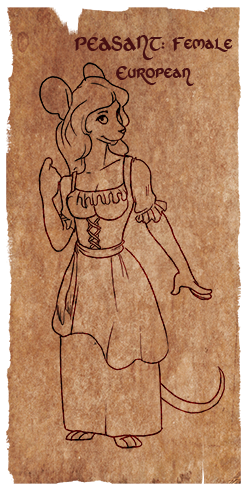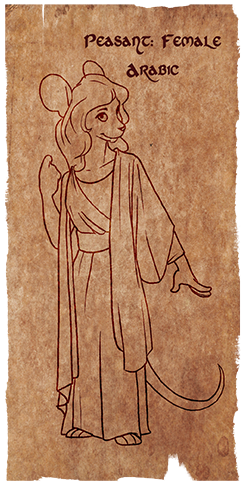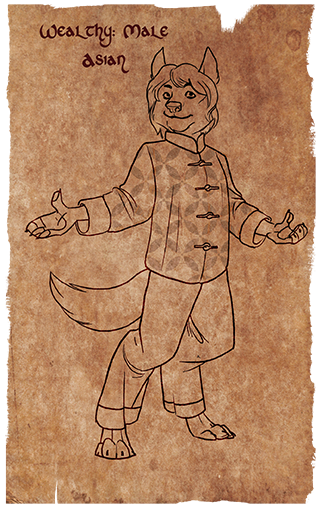 Peasants
Peasants  Slaves
Slaves  Wealthy & Nobility
Wealthy & Nobility
Guildereim and The Golden Tether especially are centers of trade and commerce, so people from many places mix and mingle here. That being said, there are some styles that are more common to the island than others, namely Tribal from the Nagas, Indian, Arabic, Asian, and 18th century English. This is just a rough guide so you know how your character is supposed to dress if they're from this area. You can mix and match among the classes and styles as you see fit.
 Tend to wear sturdy, plain clothing made to last instead of look pretty. Color of clothing is often whatever the color the material was to start with.
Tend to wear sturdy, plain clothing made to last instead of look pretty. Color of clothing is often whatever the color the material was to start with.
English/European
For males, consisted of lace or buttonup boots, breeches, and simple shirts, perhaps with a vest. Females often wore long, layered dresses with underbust corsets. Very rarely would they wear jewelery, and if they did it would be of some cheap metal or other substance.
Asian/Indian/Arabic
Mostly the same as English, though womens dresses had fewer layers and were more sari inspired and men's shirts tend to be longer. Peasant clothing is always simple.
Tribal
Tribal "peasants" are really just tribe members with no special titles/jobs. Their clothing is of natural materials, either homewoven cloth or leather and can sometimes be as little as a simple loincloth or no clothing at all depending on the tribe. Jewelery here is usually symbolic, arm bands with teeth in them, or amber, or a lock of hair from someone you love.
 Wear primarily the same as peasants, with some additions.
Wear primarily the same as peasants, with some additions.
Harem Style Attire
Gauze and silk or satin skirts, pants, vests and tops. Often these types of slaves wear little chains, ankle bells, and that similar types of jewelery. The jewelery can range from cheap trinkets to expensive baubles depending on the worth of the slave and the wealth of the owner. These types of slaves are often barefoot or wear sandals.
Silken Attire
These are basically just strips of silk artfully draped around the slave's form. Sometimes silk colors have a meaning, sometimes they don't, but they often leave very, very little to the imagination. These can be for male or female slaves. These slaves are almost always barefoot.

English/European
Dresses become bigger and more ornate. Fancy hats are a definite possibility. Men are often found wearing long jackets over their clothing and pants. Overall, the clothes are made out of finer material and more prone to wear and tear, but they don't mind because they can afford to mend or replace clothing. And they tend to be more covered than their peasant counterparts. Other than red, colors here are often muted to some extent.
Arabic
Flowing, loose robes of fine materials define this category of dress. Again, they're often more covering than their peasant counterparts. Head coverings may be used as you see fit. Colors here are often somewhat subdued.
Indian
Saris made of beautiful cloth with jewelery are very common for the women. Men often wear long overshirts that resemble a cross between the asian male's shirts and the arabic robes. Women of wealth tend to be covered in decorations of henna, jewels, or make up. Colors here are often very vibrant.
Asian
Clothing here is often much, much finer than the peasant clothing. Usually there are many layers of fine cloth and kimonos, dual buttoned shirts, and other dresses and robes are more common. Headdresses for nobility at official functions tend to be the norm.
Tribal
Tribal nobility are generally chiefs, elders, or medicine men who have a special place in the tribe. Their outfits often have more color and ornate touches to them to signify both their rank and accomplishments.

 Slaves
Slaves  Wealthy & Nobility
Wealthy & Nobility






















